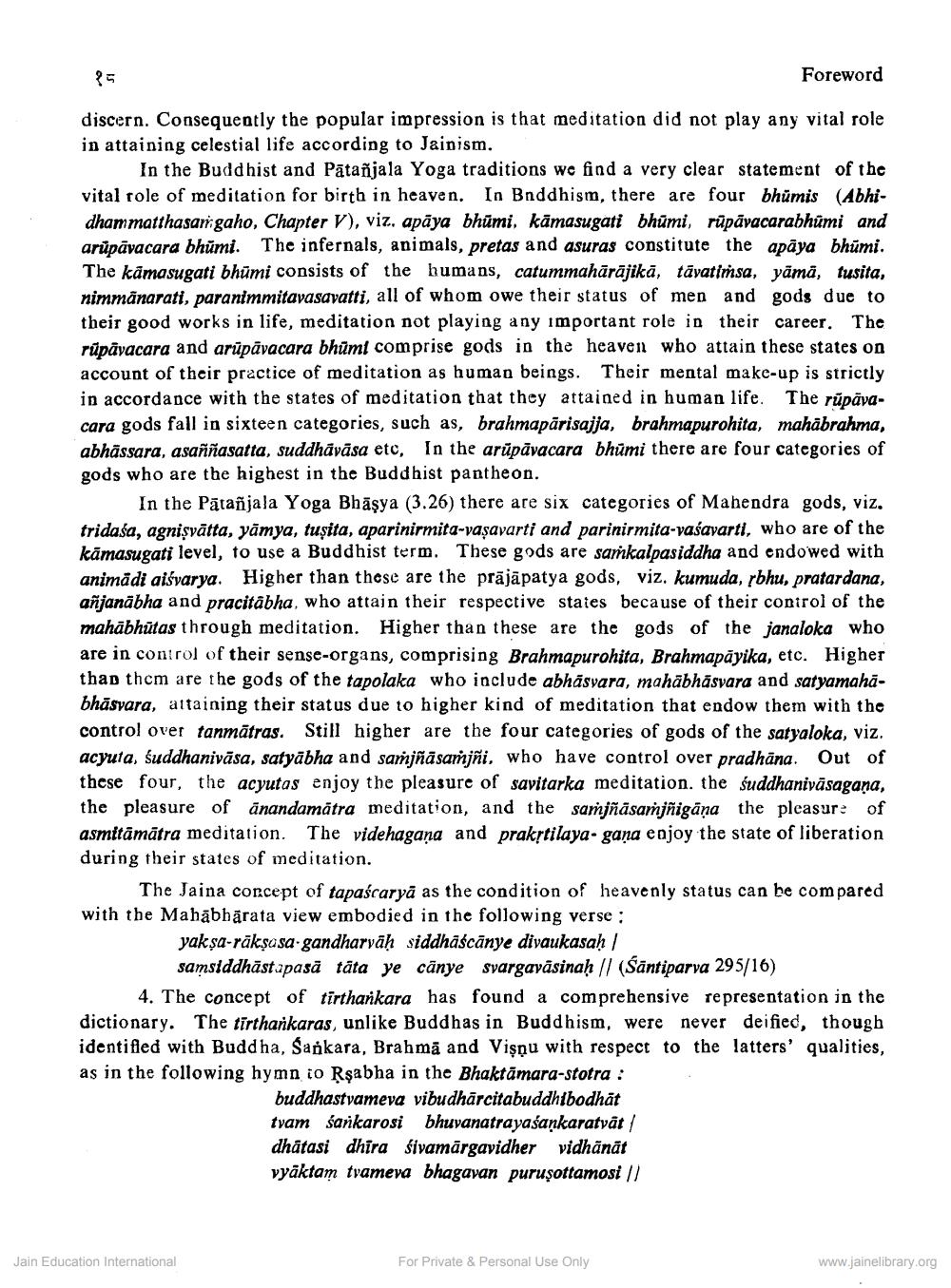________________
25
Foreword
discern. Consequently the popular impression is that meditation did not play any vital role in attaining celestial life according to Jainism.
In the Buddhist and Patañjala Yoga traditions we find a very clear statement of the vital role of meditation for birth in heaven. In Bnddhism, there are four bhümis (Abhidhammatthasargaho, Chapter V), viz. apāya bhūmi, kāmasugati bhūmi, rūpāvacarabhumi and arüdāvacara bhūmi. The infernals, animals, pretas and asuras constitute the apāya bhūmi. The kamasugati bhūmi consists of the humans, catummahārājikā, tāyatimsa, yāmā, tusita, nimmănarati, paranimmitavasavatti, all of whom owe their status of men and gods due to their good works in life, meditation not playing any important role in their career. The rūpāvacara and arūpāvacara bhūmt comprise gods in the heaven who attain these states on account of their practice of meditation as human beings. Their mental make-up is strictly in accordance with the states of meditation that they attained in human life. The rūpāvacara gods fall in sixteen categories, such as, brahmapärisajja, brahmapurohita, mahābrahma, abhāssara, asaññasatta, suddhāvāsa etc. In the arūpāvacara bhūmi there are four categories of gods who are the highest in the Buddhist pantheon.
In the Pātañjala Yoga Bhāşya (3.26) there are six categories of Mahendra gods, viz. tridaśa, agnişvātta, yāmya, tuşita, aparinirmita-vaşavarti and parinirmita-vaśavarti, who are of the kāmasugati level, to use a Buddhist term. These gods are saṁkalpasiddha and endowed with animădi aisyarya. Higher than these are the prājāpatya gods, viz. kumuda, rbhu, pratardana, añjanābha and pracitábha, who attain their respective staies because of their control of the mahābhūtas through meditation. Higher than these are the gods of the janaloka who are in control of their sense-organs, comprising Brahmapurohita, Brahmapāyika, etc. Higher than them are the gods of the tapolaka who include abhāsvara, mahābhāsvara and satyamahabhāsvara, aitaining their status due to higher kind of meditation that endow them with the control over tanmātras. Still higher are the four categories of gods of the satyaloka, viz. acyuta, śuddhanivāsa, satyabha and samjñāsamjñi, who have control over pradhana. Out of these four, the acyutas enjoy the pleasure of savitarka meditation, the suddhanivāsagana, the pleasure of ānandamátra meditation, and the samjñāsarjñigāņa the pleasure of asmitāmātra meditation. The videhagana and prakstilaya. gana enjoy the state of liberation during their states of meditation.
The Jaina concept of tapascaryā as the condition of heavenly status can be compared with the Mahābhārata view embodied in the following verse :
yakşa-rākşasa gandharvāḥ siddhāścānye divaukasah |
samsiddhāstapasā tāta ye cânye syargavāsinaḥ // (Sāntiparva 295/16)
4. The concept of tirthankara has found a comprehensive representation in the dictionary. The tīrtharkaras, unlike Buddhas in Buddhism, were never deified, though identified with Buddha, Sankara, Brahma and Vişņu with respect to the latters' qualities, as in the following hymn io Rşabha in the Bhaktāmara-stotra :
buddhastvameva vibudhārcitabuddhibodhät tvam sarkarosi bhuvanatrayasankaratvät/ dhātasi dhira śivamārgavidher vidhänāt vyāktam tvameva bhagavan puruşottamosi //
Jain Education International
For Private & Personal Use Only
www.jainelibrary.org




